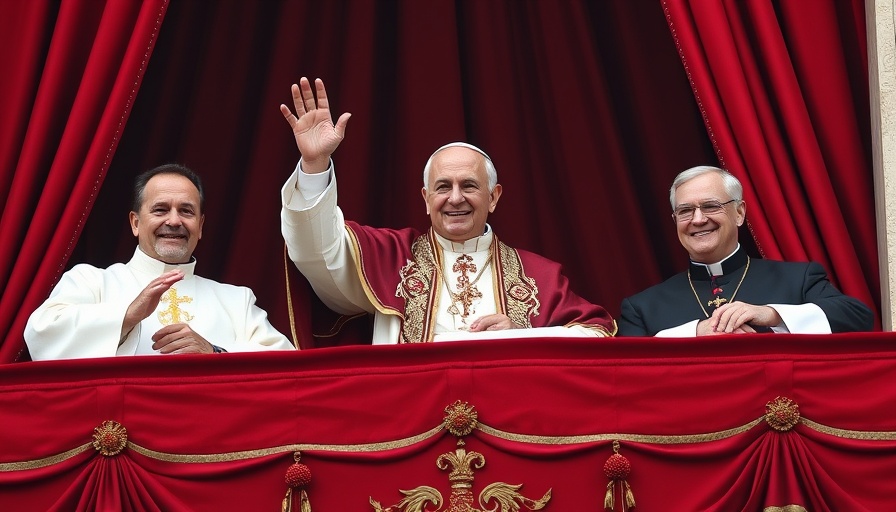
Introducing Pope Leo XIV: A Historical Milestone for the Catholic Church
In a time when the Roman Catholic Church is undergoing significant changes and challenges, the election of Cardinal Robert Francis Prevost as the first American pope, Pope Leo XIV, marks a pivotal moment not only in church history but also in the cultural landscape of the United States. Prevost's selection comes as a beacon of hope and renewal for the church's 1.4 billion followers around the globe. His ascension signals a new chapter, one where inclusivity and openness are expected to guide papal policy.
What This New Leadership Represents
Pope Leo XIV's election is more than just a personal triumph; it embodies the evolving relationship between the Vatican and the modern world. Prevost's choice to adopt the name Leo XIV pays homage to the historic popes who have navigated the church through turbulent times, but with a fresh, contemporary approach. During his inaugural address from the balcony of St. Peter's Basilica, he communicated a vision that resonated with those disillusioned by traditionalist trends within the church. By focusing on peace and compassion for the suffering, he effectively set a tone of grace that many hope will rejuvenate the faith's relevance amid modern societal issues.
Bridging Cultures: The American Angle
As the first American pontiff, Prevost holds a unique position, capable of bridging the gap between the Vatican and the vast diaspora of American Catholics. Many have long awaited this moment, expressing hope that an American pope would better understand and address the specific cultural and social challenges faced by the church in the United States. With discussions around clerical abuse, social justice, and community engagement being pivotal in recent years, Prevost's leadership could reconceptualize how the church interacts with its congregation, particularly the youth.
Future Implications for the Catholic Church
The selection of Prevost also raises questions about the direction the Catholic Church will take in addressing global issues, including climate change and economic inequality. There’s an underlying assumption that the American experience as a melting pot of cultures may inspire Pope Leo XIV to navigate these important topics with a lens of inclusivity and urgency. Given the environment he was chosen for, many expect him to continue the legacy of Pope Francis by emphasizing social responsibility, ecological stewardship, and interfaith collaboration.
Public Response and What It Means for America
The announcement elicited enthusiastic responses from Catholics and non-Catholics alike. Many expressed pride at seeing an American lead the church, a stark reminder of the vast influence the U.S. holds in global affairs. As Prevost continues to engage with varying perspectives—from conservative factions to progressive movements— Americans are hopeful that his tenure will offer them not only a more relatable papacy but also renewed interest and involvement in their faith.
Lessons from the Past: Historical Context of Papal Elections
Papal elections have historically been a reflection of the sociopolitical climate, acting as a barometer for societal shifts. The choice of Pope Leo XIV can draw parallels with previous popes who have faced their own unique sets of challenges. For example, the election of Pope John XXIII came during a time of national unrest and the need for healing after World War II. Similarly, Prevost's election serves as both a response to and a calling for healing within the church, reaffirming that the Catholic Church can evolve while maintaining its rich traditions.
The Broader Context of the Vatican’s Global Standing
Prevost's candidacy may also imply broader shifts in how the Vatican perceives its role on a global scale. As the Church grapples with dwindling numbers in Europe yet an expanding influence in developing regions, how Pope Leo XIV chooses to address these disparities will be critical. His experiences growing up in a diverse city like Chicago might serve him well in promoting a church that is both pastoral and progressive.
Conclusion: What Lies Ahead
As the Catholic Church stands on the precipice of transformation, Pope Leo XIV embodies both tradition and innovation. His unique background offers an opportunity to instill new life into the church's mission while addressing the urgent complexities facing society today. With faith, optimism, and perseverance, this new pope may very well shape the landscape of modern Catholicism for generations to come.
 Add Row
Add Row  Add
Add 




 Add Row
Add Row  Add
Add 

Write A Comment